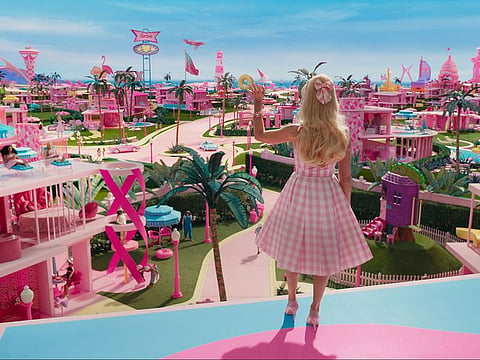Does Barbie's pink look fake? It may be Earth's oldest organic color
Beyond the Barbie biosphere, pink shows up around our planet because of certain molecules

The old-school Barbie world was filled with unrealistic representations: physically impossible body proportions, extremely high heel arches and an amazingly ostentatious house (probably hard to afford even if she was a doctor, astrophysicist and the president all at once). To tie it all together, everything c.
But the use of pink might be one of the more realistic, earthly elements in Barbie world. In fact, bright pink is one of the oldest preserved colors of a living organism on the Earth, and a common color in nature. But what is responsible for the cheery color?
Pink can sometimes seem unnatural because it's not part of the light spectrum, like the colors in a rainbow that appears after a storm. It's an extra-spectral color created through a mixture of colors, but that doesn't mean it's rare for nature to generate. (Side note: Blue is one of the least common colors in plants and animals, partly because there isn't a true blue color pigment in nature and it is due to the bending of light. Perhaps blue would have been a better color choice for a fabricated Barbie world.)
Beyond the Barbie biosphere, pink shows up around our planet because of certain molecules. Outside of green, pink is a highly common color in flowers. One class of molecules called anthocyanins can give flowers their pink color, depending on the acidity of the soil.
There are other pigments that cause colors in the red family, such as batelains, which produce the red color in beets or carnations, but "most pinks [in flowers] are caused by the red-producing anthocyanins," said botanist Elizabeth Wells.
"The more genes present for red-producing anthocyanins, the darker the reds will be, ranging from intense pure red to faint pink," said Wells, a professor at George Washington University. "When there are fewer genes, the color will be less intense and give rise to pink. In some plants there may be variations from cell to cell as to the number of genes producing red, so the color might not be uniform throughout the tissue."
Another class called carotenoids, which are yellow, orange and red pigments, can paint some animals pink. Carotenoids are synthesized in microalgae, which are eaten by animals such as shrimp and flamingos. Penguins also eat krill that feed on microalgae. Penguins are not pink, but their poo is.
But while Barbie may be 60 years old, her signature pink color dates back 1.1 billion years ago - making it the oldest color in the geologic record.
A study from 2018 suggested that pink was the first color of life on Earth, showing up in ancient rocks under the Sahara desert. Colorful organic pigments can degrade over time, but scientists extracted bits of bright pink in the marine black shales in Mauritania, West Africa.
The pink pigments came from the chlorophyll of fossilized cyanobacteria, a blue-green algae that once inhabited an ancient ocean in the Taoudeni Basin in Mauritania. The pigments were originally dark green, but the chlorophyll fossilized over thousands of years into a class of molecules called porphyrins.
Porphyrins, explained Jochen Brocks, an author of the 2018 study, are complex ring-like molecules that contain a magnesium atom at the center. Once the molecule dies, the magnesium pops out and leaves a hole in the center. Nature quickly fills the hole with a more stable atom, such as nickel (giving a blood-red color) or vanadium (inducing purple).
The team crushed the rocks to a powder, then extracted and analyzed the molecules to uncover a porphyrin with vanadium - appearing bright pink when diluted. The pink color was unexpected for the team, said Brocks, a professor of geobiology at the Australian National University.
Porphyrins "are what happens to pigment molecules like heme and chlorophyll as they degrade over hundreds of millions of years in the Earth . . . [but] pink was very surprising for all of us," said Amy McKenna, an author of the study who is an analytical chemist at the High Magnetic Field Laboratory at Florida State University.
By analyzing the isotopic composition of the pink pigment, the team learned that these tiny cyanobacteria were the dominant base of the food chain at the time. It was bacteria generating all ecosystem energy in marine environments back then, not algae as later in Earth's history, which scientists previously thought before the study, Brocks said.
"It points to an almost exclusively bacterial world before 1 billion years ago," Brocks said. "That is quite some textbook knowledge to be gleaned from an old pigment."
Sign up for the Daily Briefing
Get the latest news and updates straight to your inbox

